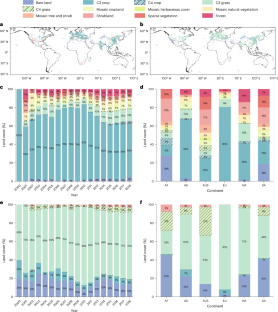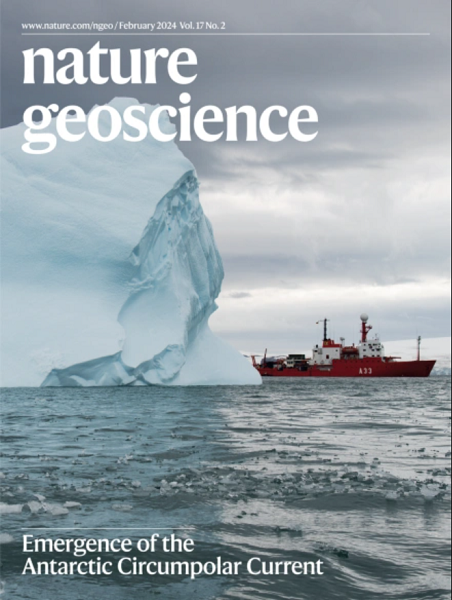增加陆地生态系统碳储量与全球公用事业规模的光伏安装有关
IF 16.1
1区 地球科学
Q1 GEOSCIENCES, MULTIDISCIPLINARY
引用次数: 0
摘要
由于其低碳足迹,公用事业规模的光伏(USPV)作为最重要的可再生能源技术之一脱颖而出,对实现全球气候目标至关重要。虽然存在个别案例研究,但仍缺乏对USPV部署对土地覆盖变化和随后不同生态系统碳库动态的影响的全面全球分析。本文表明,根据多个数据集的综合平均值,2000年至2018年期间全球部署的USPV电站将在其生命周期内使宿主生态系统的碳库增加2.1 TgC。尽管与全球USPV部署相关的碳库变化目前贡献了USPV工厂碳足迹的大约\({15.9}_{-5.8}^{+1.0}\%\) (\({{{\mathrm{ensemble}}\; {\mathrm{mean}}}}_{-{{\mathrm{difference}}\; {\mathrm{to}}\; {\mathrm{percentile}}}\,25}^{+{{\mathrm{difference}}\; {\mathrm{to}}\; {\mathrm{percentile}}}\,75}\))(或平均绝对碳足迹约为\({10.5}_{-3.8}^{+0.5}\,{\mathrm{g}}\)二氧化碳当量每千瓦时),但预计到2050年,这一份额将增加约7倍,主要是由于光伏制造排放的减少。值得注意的是,优化土地管理策略可以潜在地提高现有USPV电站的托管生态系统中的碳密度,大约\({3.0}_{-0.4}^{+3.7}\,{\mathrm{kgC}}\,{\mathrm{m}}^{-2}\),从而促进这些USPV电站的碳足迹平均减少\({4.3}_{-0.2}^{+9.3}\%\)。本文章由计算机程序翻译,如有差异,请以英文原文为准。


Increased terrestrial ecosystem carbon storage associated with global utility-scale photovoltaic installation
Utility-scale photovoltaic (USPV) stands out as one of the foremost renewable energy technologies crucial for achieving global climate targets, owing to its low carbon footprint. While individual case studies exist, a comprehensive global analysis of the impacts of USPV deployment on land-cover changes and subsequent carbon pool dynamics across diverse ecosystems remains lacking. Here we show that worldwide deployment of USPV plants between 2000 and 2018 would increase the carbon pool of the hosting ecosystem by a total of 2.1 TgC over their lifespans, as revealed by the ensemble mean of multiple datasets. Although the carbon pool changes associated with global USPV deployment currently contribute approximately $${15.9}_{-5.8}^{+1.0}\%$$ ( $${{{\mathrm{ensemble}}\; {\mathrm{mean}}}}_{-{{\mathrm{difference}}\; {\mathrm{to}}\; {\mathrm{percentile}}}\,25}^{+{{\mathrm{difference}}\; {\mathrm{to}}\; {\mathrm{percentile}}}\,75}$$ ) (or an average absolute carbon footprint of approximately $${10.5}_{-3.8}^{+0.5}\,{\mathrm{g}}$$ CO2-equivalent per kilowatt-hour) of the carbon footprint of USPV plants, this share is projected to increase by around 7-fold by 2050, driven primarily by decreasing photovoltaic manufacturing emissions. Notably, optimizing land management strategies can potentially enhance carbon density in the hosting ecosystem of existing USPV plants by approximately $${3.0}_{-0.4}^{+3.7}\,{\mathrm{kgC}}\,{\mathrm{m}}^{-2}$$ , thereby facilitating an average reduction of $${4.3}_{-0.2}^{+9.3}\%$$ in the carbon footprint of these USPV plants. A utility-based assessment shows that the global installation of photovoltaic plants to harness solar energy between 2000 and 2018 led to an increase in terrestrial ecosystem carbon pools of 2.1 TgC.
求助全文
通过发布文献求助,成功后即可免费获取论文全文。
去求助
来源期刊

Nature Geoscience
地学-地球科学综合
CiteScore
26.70
自引率
1.60%
发文量
187
审稿时长
3.3 months
期刊介绍:
Nature Geoscience is a monthly interdisciplinary journal that gathers top-tier research spanning Earth Sciences and related fields.
The journal covers all geoscience disciplines, including fieldwork, modeling, and theoretical studies.
Topics include atmospheric science, biogeochemistry, climate science, geobiology, geochemistry, geoinformatics, remote sensing, geology, geomagnetism, paleomagnetism, geomorphology, geophysics, glaciology, hydrology, limnology, mineralogy, oceanography, paleontology, paleoclimatology, paleoceanography, petrology, planetary science, seismology, space physics, tectonics, and volcanology.
Nature Geoscience upholds its commitment to publishing significant, high-quality Earth Sciences research through fair, rapid, and rigorous peer review, overseen by a team of full-time professional editors.
 求助内容:
求助内容: 应助结果提醒方式:
应助结果提醒方式:


